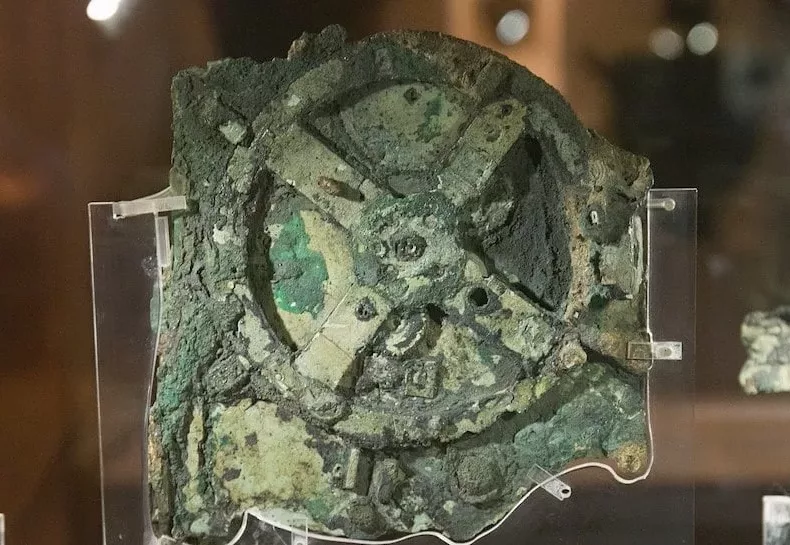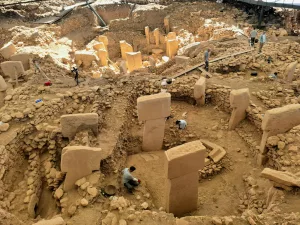Over 2,000 years ago, the ancient Greeks constructed a device so advanced that its purpose and function mystified scientists for centuries. Discovered in a shipwreck off the coast of the Greek island of Antikythera in 1901, the Antikythera Mechanism has since been hailed as the world’s first analog computer. This intricate, gear-driven device was capable of tracking celestial movements with remarkable precision, demonstrating a level of technological sophistication that seemed far ahead of its time. Today, the Antikythera Mechanism is celebrated as both an engineering marvel and a window into the brilliance of ancient Greek science and innovation. In this article, we’ll delve into what the Antikythera Mechanism is, how it worked, and the profound ways it impacts our understanding of history and technology.
What Is the Antikythera Mechanism?
The Antikythera Mechanism is a complex, gear-operated device constructed in ancient Greece around 100 BCE. It was discovered in a Roman-era shipwreck near Antikythera, a small Greek island, and has since been the subject of intense study and fascination. Made of bronze, the mechanism consists of a series of interlocking gears housed within a wooden frame, with dials and inscriptions providing detailed astronomical data.
While heavily corroded and fragmented when it was found, modern analysis has revealed that the device was used to predict astronomical events such as eclipses, track the phases of the moon, and even determine the positions of planets. Its construction suggests a mastery of mathematics, engineering, and astronomy that challenges traditional views of ancient technology.
Functions of the Antikythera Mechanism
1. Tracks the Phases of the Moon
One of the primary functions of the Antikythera Mechanism was to track the phases of the moon. Using a set of finely calibrated gears, the device simulated the moon’s orbit around the Earth, accounting for its elliptical trajectory and variations in speed. This allowed ancient users to predict the moon’s phases, such as full moons and new moons, with remarkable accuracy.
This lunar tracking capability would have been invaluable for ancient Greek society, as the moon played a central role in agricultural planning, religious festivals, and navigation. The mechanism’s precision underscores the Greeks’ deep understanding of lunar cycles and celestial mechanics.
2. Predicts Solar and Lunar Eclipses
The Antikythera Mechanism was also designed to predict solar and lunar eclipses. Using a combination of dials and inscriptions, it provided information on the timing, duration, and type of eclipse (e.g., total, partial, or annular). This capability suggests that the mechanism was not only a scientific tool but also held cultural and possibly religious significance.
Eclipse prediction required advanced mathematical models and astronomical observations, demonstrating the Greeks’ ability to apply theoretical knowledge to practical technology. The mechanism’s accuracy in this regard remains one of its most astonishing features.
3. Tracks the Zodiac and the Sun’s Movement
The mechanism included a zodiac dial, which allowed users to track the movement of the sun through the constellations of the zodiac. This function was important for determining the time of year and aligning calendars with seasonal changes. The zodiac dial also helped predict the positions of celestial bodies, which was critical for navigation and agricultural cycles.
By incorporating both solar and lunar cycles, the Antikythera Mechanism served as an early astronomical calendar, enabling ancient Greeks to synchronize their activities with the rhythms of the cosmos.
4. Models Planetary Movements
Recent studies suggest that the Antikythera Mechanism may have been capable of modeling the movements of the five known planets of the ancient world: Mercury, Venus, Mars, Jupiter, and Saturn. Through intricate gearing systems, it simulated the retrograde motions of these planets, a phenomenon where planets appear to move backward in the sky due to Earth’s relative position.
This level of complexity demonstrates that ancient Greek astronomers had a sophisticated understanding of planetary orbits and the concept of epicycles, which they used to explain planetary motion before the heliocentric model was developed.
5. Serves as an Educational Tool
The Antikythera Mechanism likely served as a teaching device, illustrating complex astronomical concepts in a tangible and interactive way. By visualizing celestial movements and cycles, the mechanism could have been used to educate students, scholars, and navigators about astronomy and mathematics.
Its inscriptions, which provide instructions and explanations, further suggest that it was intended for practical use, making advanced scientific knowledge accessible to its users. This reinforces the idea that the mechanism was both a tool for learning and a symbol of intellectual achievement.
How the Antikythera Mechanism Impacts Our Understanding of History
6. Challenges Assumptions About Ancient Technology
The Antikythera Mechanism has redefined our understanding of ancient technology, demonstrating that advanced engineering and scientific knowledge existed far earlier than previously believed. Its intricate design rivals the complexity of clocks developed over 1,000 years later during the European Renaissance.
The mechanism’s discovery challenges the assumption that ancient societies lacked the technical expertise to create such sophisticated devices. Instead, it highlights the ingenuity of ancient Greek engineers and their ability to apply mathematical theories to practical inventions.
7. Highlights the Greek Legacy in Science and Engineering
The Antikythera Mechanism showcases the scientific and engineering prowess of ancient Greece. It reflects the Greeks’ dedication to understanding the natural world through observation, calculation, and experimentation. The device also underscores their ability to integrate knowledge from various disciplines, such as astronomy, mathematics, and metallurgy.
By studying the mechanism, modern researchers gain insight into the intellectual culture of ancient Greece and the ways in which scientific knowledge was developed and preserved. It serves as a testament to the enduring impact of Greek contributions to science and technology.
8. Connects Ancient and Modern Technology
The Antikythera Mechanism is often regarded as a precursor to modern mechanical devices, such as clocks and computers. Its use of gears, ratios, and dials to perform calculations mirrors the principles underlying contemporary analog and digital technologies.
By bridging the gap between ancient and modern engineering, the mechanism provides a historical foundation for understanding the evolution of technology. It reminds us that many of the concepts we rely on today have roots in ancient innovation.
9. Inspires Interdisciplinary Research
The study of the Antikythera Mechanism has inspired collaborative research across disciplines, including archaeology, engineering, astronomy, and computer science. Modern imaging techniques, such as X-ray tomography, have been used to reconstruct the mechanism’s structure and function, revealing new details about its design.
This interdisciplinary approach not only deepens our understanding of the mechanism but also demonstrates the value of combining scientific and humanistic perspectives to solve complex problems.
10. Fuels Interest in Ancient Astronomy
The Antikythera Mechanism has rekindled interest in ancient astronomy, shedding light on how early civilizations observed and interpreted the cosmos. It reveals that the Greeks were not only keen observers of the heavens but also skilled in translating their observations into practical tools.
By studying the mechanism, researchers and enthusiasts alike gain a deeper appreciation for the history of astronomy and the ways in which ancient societies sought to understand their place in the universe.
11. Preserves Ancient Mathematical Knowledge
The Antikythera Mechanism reflects the advanced mathematical principles understood by the ancient Greeks, including geometry, ratios, and the concept of epicycles. The precision of its gears and calculations suggests that its creators had a deep grasp of mathematics, which they applied to practical technology.
Studying the mechanism provides valuable insights into the mathematical knowledge of ancient civilizations, showcasing their ability to solve complex problems. This preservation of ancient mathematical concepts highlights the interconnectedness of science, engineering, and mathematics in human history.
12. Provides Insight into Ancient Navigation
The Antikythera Mechanism was likely used to support ancient navigation, as its ability to track celestial movements would have been invaluable for sailors. By predicting the positions of the sun, moon, and planets, the device could help mariners chart courses and determine their position relative to celestial markers.
This functionality underscores the practical applications of ancient Greek astronomy and engineering in exploration and trade. The mechanism’s role in navigation reveals the importance of technological innovation in the expansion of ancient civilizations.
13. Demonstrates the Value of Collaboration
The creation of the Antikythera Mechanism required a multidisciplinary effort, combining expertise in metallurgy, astronomy, and mechanical engineering. Its development exemplifies the collaborative spirit of ancient Greek society, where knowledge from different fields was integrated to achieve extraordinary results.
The mechanism serves as a reminder that progress often stems from the synthesis of diverse skills and ideas. This spirit of collaboration continues to inspire modern scientific and technological advancements.
14. Encourages Modern Engineering Innovations
By studying the intricate design of the Antikythera Mechanism, engineers and scientists gain inspiration for modern innovations. The precision and ingenuity of its gearing system provide valuable lessons for contemporary mechanical and computational technologies.
Researchers have even drawn parallels between the mechanism and modern analog computers, emphasizing its role as a foundational invention. The study of ancient technology often sparks fresh ideas for solving present-day engineering challenges.
15. Highlights the Importance of Preservation
The discovery and study of the Antikythera Mechanism emphasize the value of preserving historical artifacts. Found in a shipwreck, the mechanism remained hidden for centuries, but its recovery has provided profound insights into ancient technology and culture.
This underscores the importance of protecting archaeological sites and artifacts, as they hold the potential to reshape our understanding of history. The Antikythera Mechanism serves as a powerful example of how a single artifact can revolutionize our knowledge of the past.
16. Advances Imaging and Reconstruction Technologies
The effort to understand the Antikythera Mechanism has driven technological advancements in imaging and reconstruction. Techniques like X-ray tomography and 3D modeling have been used to reveal the internal structure of the mechanism and decipher its inscriptions.
These advancements not only illuminate the mysteries of the Antikythera Mechanism but also enhance tools available to archaeologists and scientists for studying other ancient artifacts. The mechanism’s study has thus had a ripple effect, advancing fields beyond its own historical significance.
17. Demonstrates the Timeless Nature of Innovation
The Antikythera Mechanism reminds us that innovation transcends time. Its creators, working over two millennia ago, solved complex problems using the tools and knowledge available to them, achieving results that continue to amaze modern researchers.
This realization fosters a sense of continuity in human ingenuity, connecting ancient achievements with modern advancements. It inspires us to appreciate the creativity and resourcefulness of all cultures and eras.
18. Challenges Eurocentric Views of Technological History
The Antikythera Mechanism challenges the notion that advanced technology only emerged during the European Renaissance. Its discovery highlights the achievements of ancient Greek civilization and forces us to reconsider the timeline of technological progress.
By acknowledging the sophistication of ancient cultures, we gain a more inclusive understanding of history, recognizing contributions from diverse civilizations. The mechanism serves as a reminder of the global and enduring nature of human innovation.
19. Inspires Public Interest in Science and History
The Antikythera Mechanism has captured the imagination of scholars and the public alike, sparking widespread interest in science and history. Its story, from its discovery in a shipwreck to its detailed study using modern technology, showcases the excitement of uncovering the past.
Museums, documentaries, and academic papers on the mechanism have made its story accessible to a broad audience, inspiring curiosity about ancient civilizations and their achievements. This renewed interest supports educational efforts and fosters a deeper appreciation for the interconnectedness of history and science.
20. Represents the Intersection of Art and Science
The Antikythera Mechanism is not only a scientific instrument but also a work of art. Its intricate design, elegant gearing system, and detailed inscriptions demonstrate the artistry involved in its creation. The mechanism reflects a deep appreciation for both functionality and beauty, blending technical precision with aesthetic sophistication.
This intersection of art and science continues to resonate in modern times, reminding us that innovation is often born from a marriage of creativity and technical skill. The Antikythera Mechanism embodies this balance, making it a timeless symbol of human achievement.
Conclusion
The Antikythera Mechanism stands as a testament to the ingenuity of ancient Greek civilization, blending science, engineering, and art into a device that continues to astonish modern researchers. Its ability to track celestial movements, predict eclipses, and model planetary orbits underscores the advanced understanding of astronomy and mechanics held by its creators. Beyond its technical brilliance, the mechanism offers profound insights into the cultural, scientific, and historical context of its time.
As we continue to study the Antikythera Mechanism, it inspires a deeper appreciation for the legacy of ancient innovation and reminds us that human curiosity and creativity are timeless forces driving progress. By exploring this ancient marvel, we not only learn about the past but also gain inspiration for the future.




